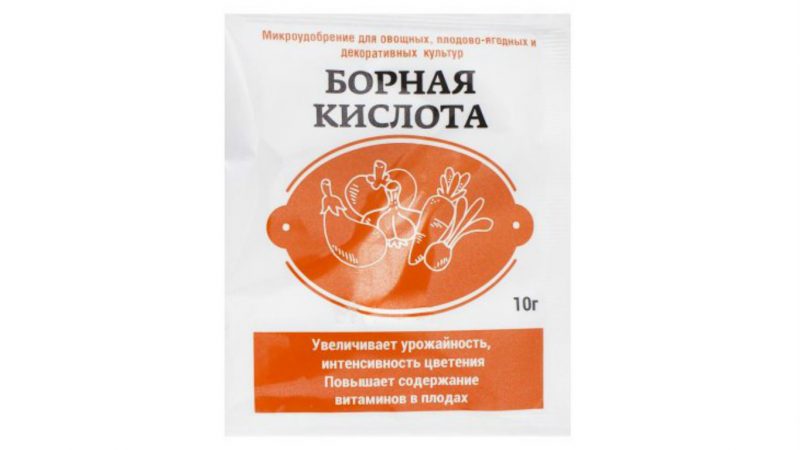For gardeners, boric acid is an excellent tool to help grow plants. The tool increases productivity and activates the formation of ovaries on plants. The main thing is to know exactly what the use of boric acid should be for plants.
Material Content:
How beneficial is boric acid for plants?
The use of boric acid in growing plants has certain advantages.

The substance has the following beneficial effects on plants:
- growth stimulation;
- an increase in the volume of chlorophyll;
- increasing the ability to root seedlings;
- bushes strengthening;
- activation of the ovary.
When spraying plants with a solution of boric acid, it is possible to increase the survival of plantings under adverse weather conditions, at the time of a dive, or when diseases and pests occur in plants. Also, the substance increases the sweetness of the fruit, which makes the crop tastier.
It is very difficult to cause damage to the plantings when using boric acid, which is why most gardeners consider the product to be the safest. However, you can overfeed the plants with boric acid, in which case the leaves will take a dome shape (their edges will be bent down). Eating a crop oversaturated with boron is also not useful, which is important to consider. Boric acid for plants is a mandatory fertilizer, which, like everything, should be applied in moderation.
Signs of a lack of boron in garden and garden plants
It is possible to determine that a plant is experiencing boron deficiency by a number of signs. Notice them easy even a novice gardener. A deficit in the soil of the substance is indicated by some changes that occur with crops.
- The leaves of the trees significantly thicken, and their deformation occurs. Seals are usually in the form of spots. Gradually yellowing of the leaves and their death. If boron deficiency is especially severe, then the top of a tree can die off in trees. Stains form on the fruits, and tubercles in the upper part.
- If boron deficiency occurs in grapes, then spots develop on its leaves, in areas between the veins, which gradually spread to the entire leaf plate and lead to drying. Ovary falling may also occur. When young shoots do not receive enough boron, the probability of their death in 2-3 years is high. This process looks like a general gradual withering of the vine.
- Tomatoes respond to a lack of boron by dying off the tops. At the same time, closer to the root, a large number of new shoots appear, which are particularly fragile.
- Not infrequently, potato suffers from a deficiency of matter. Most often, during starvation, the plant is affected by a scab of fungal nature. The bushes are far behind in development, their leaves begin to turn yellow, and the petioles, in turn, turn red. The phenomenon occurs with increased soil acidity or excessive use of potash and nitrogen fertilizers.
- Beetroot responds to a deficiency of the substance by the development of phimosis. At the beginning of the disease, only the leaves of the culture suffer, on which dried spots form. Further, the disease spreads to the root crop - it begins to rot from the inside. A black flabby core is visible in its section. There is no such beet.
- Flowers with a lack of boron in the soil begin to lay small buds, and the color intensity of the flowers is significantly reduced. Perennial crops gradually wither away, and annuals wither away sooner than they should.
When boron deficiency symptoms occur, treatment of the plant with boric acid is indicated, with a solution of which it is watered or sprayed.
The use of boric acid for plants
In order to ensure high-quality growth of plants and get a plentiful harvest, you must know exactly how to use boric acid. This will provide the crops with the right nutrition and not overfeed the plantings.
How much boron do plants need?
Boron is required by plants throughout the growing season. Depending on the state of culture, the amount of substance consumed varies. For the proper application of top dressing, you should know exactly which crops are especially in need of a substance, and which cost a minimum of its quantity.
| High need | Cabbage, beets, pears, apple trees |
| Average need | Stone fruits, tomatoes, carrots, salad |
| Low need | Legumes, potatoes, strawberries, grass |
Potatoes and strawberries react most acutely and violently to boron deficiency, despite the fact that they belong to the latter group according to the need of the substance.
Soil preparation for sowing and planting
Preparing the soil for seedlings, it is treated with boric acid. 0.2 g of substance are dissolved in 1 liter of warm water. Later it is watered at the rate of 1 liter per 1 m2. Such boron application is required both when preparing the soil for seedlings, and when processing beds and greenhouses.
What plants can be sprayed?
Spraying plants with boric acid is an excellent way of feeding, but it can be applied to not all crops. Do not treat eggplant, pumpkin and zucchini. The rest of the crop, including berry, shrubs, fruit trees, cruciferous, root crops and onions, can be fed by spraying. It is considered the most convenient form for fertilizing, because in this case the substance is distributed evenly throughout the plant.At the same time, the risk of burning the planting is completely eliminated. Acid dissolves in the same way as for tillage.
Plant Nutrition with Boric Acid
When plant nutrition is carried out, it is important not to leave the cooked preparation for a long time. It is optimal to use the entire solution immediately. For top dressing with the introduction of soil in a liter of water, 0.2 g of substance is dissolved. For spraying, if the lack of boron is barely noticeable, from 0.1 to 0.2 g per liter can be used. Each grower should know how to breed boric acid for spraying and tillage.
Top dressing under the root

This type of top dressing is used if the deficiency of boron is precisely established, and not just suspicions are present. Previously, the plant is very abundantly watered with warm, settled water, and then with a solution. Pouring it should not just be at the root, but a little grabbing the stem. Such top dressing is a shock dose of boron, capable of saving even a plant, which, due to a deficiency of matter, is on the verge of death.
How to dilute the substance yourself correctly?
Boric acid is sold in the form of a powder or solution. If the substance is purchased in the first form, then it will be required to competently dissolve it.
It is most convenient to dissolve the powder in a small portion of water and then add the required volume. Water for this is taken warm. Having poured the substance into the dishes, add water and dissolve it, stirring continuously. Draft should not remain. After receiving the concentrate, it is diluted with water to the desired state.
How to spray?

Spraying should be done early in the morning or late in the evening. The weather is chosen dry and windless. If the plants are in open ground, you need to make sure that there will be no rain in the next 24 hours. Since boric acid acts only on the leaves where it fell, spraying should be carried out regularly, so that new leaves that open on the bush receive good nutrition.
What is the effect of the application?
Fertilizing plants with boric acid gives the effect that every gardener notices. Productivity of plantings increases by 20-30%, and the quality of vegetables and berries is significantly improved. Even if there is a shortage of sunlight, the sugar content in the fruits is as high as possible, since boron provokes their active accumulation.

Fertilizer is also an excellent remedy against most pests, since boric acid after getting into them in the body causes serious disruptions in the functioning of the body's systems, from which insects die.
- Flowers after using boric acid gain a larger number of buds, which differ in maximum sizes. The flowering period is also significantly extended, especially in annuals, which retain an attractive appearance until the frost.
- When seedlings are planted, their treatment with boric acid allows you to achieve the fastest complete rooting. Also, plants begin to actively produce shoots and form good bushes. As a stimulant for the growth of seedlings and seedlings, the acid showed its best side.
Strawberry bushes after spraying with boric acid begin to actively release a mustache and lay buds and ovaries. Plants selected for propagation are stimulated by acid. This allows you to get a plentiful and strong mustache. Fertilizing will also help new plants to take root better.
How to use boric acid to combat ants and other insects?
Boric acid copes with many garden pests. It is customary to use the substance as a safe means for eliminating unsolicited insects, as well as ants. From the aphids and other pests that live on plants, the affected bushes are simply sprayed with a solution. From ants, acid is used in a slightly different way.
The most effective ways:
- 2 boiled yolks are mixed with ½ teaspoon of acid powder. The composition is triturated to a homogeneous mass.Next, pea-sized balls are rolled from it and placed near anthills and on ant paths.
- 3 yolks are mixed with 3 crushed jacket potatoes in their skins, a teaspoon of sugar and 10 g of acid. Then, balls are made from the mixture, which are placed near the anthills.
In both the first and second cases, the insects take the balls for food, which they hasten to carry to the anthill. After they eat the compound with acid, it destroys them from the inside, quickly destroying the entire family.
Boric acid should be present in the arsenal of each gardener.












